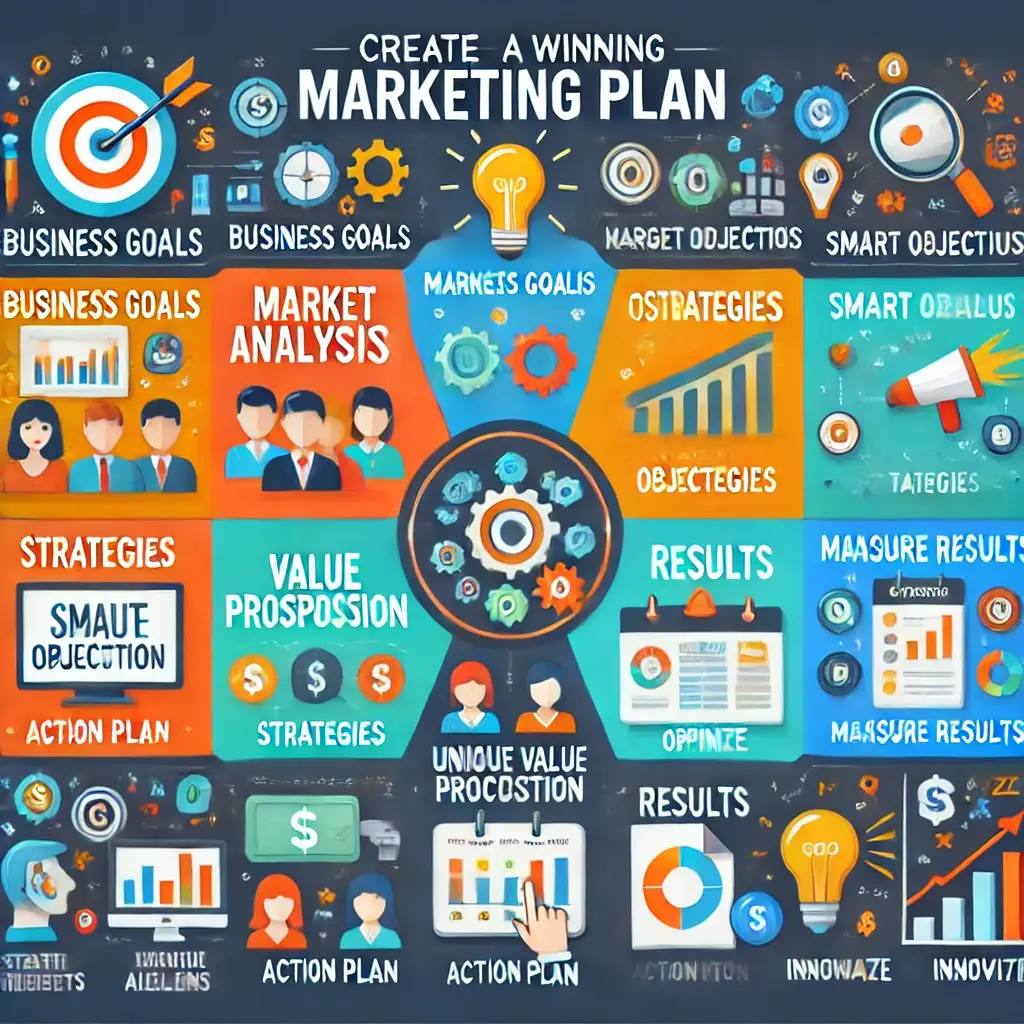Creating a winning marketing plan involves thorough research, strategic thinking, and clear objectives. Here's a step-by-step guide:
1. Understand Your Business Goals
Your marketing plan should align with your overall business goals. Identify:
- What you want to achieve: Increase sales, brand awareness, customer retention, etc.
- Target metrics: Revenue growth, market share, or number of leads.
2. Analyze Your Market
Conduct a detailed analysis to understand the landscape:
- Industry trends: What’s happening in your sector?
- Competitors: Who are they? What are their strengths, weaknesses, and strategies?
- Customer insights:
- Who are your ideal customers (demographics, psychographics)?
- What problems are they trying to solve?
- Where do they spend their time (online, offline)?
3. Define Your Target Audience
Segment your audience for precise targeting:
- Create buyer personas that represent your ideal customers.
- Segment based on demographics (age, gender, location), behaviors (online habits, buying patterns), or needs.
4. Set SMART Marketing Objectives
Ensure your goals are:
- Specific: Clear and focused.
- Measurable: Quantifiable metrics like a 20% increase in website traffic.
- Achievable: Realistic within your resources.
- Relevant: Align with business goals.
- Time-bound: Define deadlines.
5. Develop Your Unique Value Proposition (UVP)
Define what makes your product or service stand out:
- Why should customers choose you?
- Highlight key benefits that solve customer problems better than competitors.
6. Choose Your Marketing Strategies
Select strategies based on your objectives and audience:
- Content Marketing: Blog posts, videos, infographics, and ebooks.
- Social Media Marketing: Use platforms like Facebook, Instagram, LinkedIn, or TikTok.
- Search Engine Optimization (SEO): Optimize your website for organic traffic.
- Email Marketing: Build relationships and drive conversions.
- Paid Advertising: Google Ads, Facebook Ads, or influencer marketing.
- Partnerships: Collaborate with complementary businesses or influencers.
7. Outline Your Budget
Allocate resources effectively:
- Determine the budget for each channel or campaign.
- Factor in costs for content creation, advertising, tools, and team members.
8. Create a Detailed Action Plan
Break down each strategy into actionable steps:
- Define responsibilities: Assign tasks to team members or departments.
- Set timelines: Create a marketing calendar with deadlines.
- Use tools: Project management software like Asana or Trello to track progress.
9. Track and Measure Results
Monitor your campaigns to evaluate success:
- Use analytics tools like Google Analytics, Facebook Insights, or HubSpot.
- Measure key performance indicators (KPIs), such as:
- Website traffic
- Conversion rates
- ROI (Return on Investment)
- Adapt strategies based on performance data.
10. Optimize and Iterate
Use insights to refine your plan:
- Identify what’s working and scale it up.
- Address underperforming areas with new strategies or adjustments.
- Continuously test new ideas (A/B testing).
11. Ensure Team Alignment
Communicate your marketing plan across the organization:
- Share goals, strategies, and expected outcomes.
- Ensure cross-department collaboration for consistency in messaging.
12. Stay Agile and Innovative
Markets evolve rapidly, so:
- Keep up with industry trends and technology.
- Experiment with new tools, platforms, and techniques.
- Be prepared to pivot strategies if needed.
Example Outline for a Marketing Plan
- Executive Summary: Overview of the plan.
- Market Analysis: Insights about the industry, competitors, and customers.
- Target Audience: Detailed customer personas.
- Objectives: SMART goals.
- Strategies and Tactics: Marketing mix (product, price, place, promotion).
- Budget: Allocation of funds.
- KPIs and Metrics: What success looks like.
- Action Plan: Timelines and responsibilities.
- Evaluation: How you’ll monitor and optimize performance.
A winning marketing plan is dynamic, data-driven, and customer-focused. Regularly revisiting and updating it ensures continued success.
